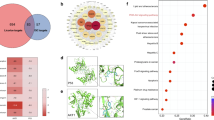Abstract
Purpose
Several therapeutic agents have been found to prevent myocardial ischemic and reperfusion (I/R) injury after cardiac surgery; however, no drug is routinely used to afford cardioprotective benefits in clinical settings. Herein, we aimed to determine whether chloroquine (CQ) pretreatment attenuates I/R injury after global ischemia in isolated rat hearts and elucidate mechanisms underlying the effects of CQ.
Methods
Isolated rat hearts were subjected to 30-min global ischemia, followed by 60-min reperfusion with Krebs–Henseleit buffer (KHB). Immediately before ischemia, 10 mL of pretreatment solutions (KHB, n = 4 or KHB + CQ [100 μM], n = 4) were injected through the aortic root. Cardiac function was examined based on the rate pressure product (RPP). Myocardial apoptosis was evaluated using TUNEL staining. To assess the reperfusion ischemia salvage kinase pathway, protein expression levels of AKT and extracellular signal-regulated kinase (ERK1/2) were determined using western blotting. To investigate the role of ERK1/2, an ERK1/2 selective inhibitor was used in eight additional rats.
Results
The recovery rate of the RPP was higher in the KHB + CQ group than in the KHB group 60 min after I/R (KHB, 44 ± 3% vs. KHB + CQ, 69 ± 7%; P = 0.019, d = 2.2). CQ pretreatment reduced apoptosis and enhanced the phosphorylation of ERK1/2; however, AKT phosphorylation was unaltered. In addition, the ERK1/2 inhibitor abolished CQ-mediated cardioprotective effects.
Conclusions
CQ pretreatment showed protective effects on cardiac function after I/R by activating ERK1/2.






Similar content being viewed by others
Data availability
The data sets generated during the current study will be shared on reasonable requests to the corresponding author.
References
Hausenloy DJ, Yellon DM (2013) Myocardial ischemia-reperfusion injury: a neglected therapeutic target. J Clin Investig 123:92–100. https://doi.org/10.1172/JCI62874
Roth S, Torregroza C, Feige K et al (2021) Pharmacological conditioning of the heart: an update on experimental developments and clinical implications. Int J Mol Sci. https://doi.org/10.3390/ijms22052519
Todorovic Z, Medic B, Basta-Jovanovic G et al (2014) Acute pretreatment with chloroquine attenuates renal I/R injury in rats. PLoS ONE 9:e92673. https://doi.org/10.1371/journal.pone.0092673
Zhang YP, Cui QY, Zhang TM et al (2020) Chloroquine pretreatment attenuates ischemia-reperfusion injury in the brain of ob/ob diabetic mice as well as wildtype mice. Brain Res 1726:146518. https://doi.org/10.1016/j.brainres.2019.146518
Hausenloy DJ, Yellon DM (2004) New directions for protecting the heart against ischaemia-reperfusion injury: targeting the Reperfusion Injury Salvage Kinase (RISK)-pathway. Cardiovasc Res 61:448–460. https://doi.org/10.1016/j.cardiores.2003.09.024
Ma S, Wang Y, Chen Y, Cao F (2015) The role of the autophagy in myocardial ischemia/reperfusion injury. Biochim Biophys Acta 1852:271–276. https://doi.org/10.1016/j.bbadis.2014.05.010
Baird JK (2005) Effectiveness of antimalarial drugs. N Engl J Med 352:1565–1577. https://doi.org/10.1056/NEJMra043207
Klionsky DJ, Abdel-Aziz AK, Abdelfatah S et al (2021) Guidelines for the use and interpretation of assays for monitoring autophagy (4th edition)(1). Autophagy 17:1–382. https://doi.org/10.1080/15548627.2020.1797280
Kim HY (2014) Statistical notes for clinical researchers: two-way analysis of variance (ANOVA)-exploring possible interaction between factors. Restor Dent Endod 39:143–147. https://doi.org/10.5395/rde.2014.39.2.143
Sullivan GM, Feinn R (2012) Using effect size-or why the P value is not enough. J Grad Med Educ 4:279–282. https://doi.org/10.4300/JGME-D-12-00156.1
Widmann C, Gibson S, Jarpe MB, Johnson GL (1999) Mitogen-activated protein kinase: conservation of a three-kinase module from yeast to human. Physiol Rev 79:143–180. https://doi.org/10.1152/physrev.1999.79.1.143
Beguin PC, Belaidi E, Godin-Ribuot D, Levy P, Ribuot C (2007) Intermittent hypoxia-induced delayed cardioprotection is mediated by PKC and triggered by p38 MAP kinase and Erk1/2. J Mol Cell Cardiol 42:343–351. https://doi.org/10.1016/j.yjmcc.2006.11.008
Bourke L, McCormick J, Taylor V et al (2015) Hydroxychloroquine protects against cardiac ischaemia/reperfusion injury in vivo via enhancement of ERK1/2 phosphorylation. PLoS ONE 10:e0143771. https://doi.org/10.1371/journal.pone.0143771
Baxter GF, Mocanu MM, Brar BK, Latchman DS, Yellon DM (2001) Cardioprotective effects of transforming growth factor-beta1 during early reoxygenation or reperfusion are mediated by p42/p44 MAPK. J Cardiovasc Pharmacol 38:930–939. https://doi.org/10.1097/00005344-200112000-00015
Thome R, Moraes AS, Bombeiro AL et al (2013) Chloroquine treatment enhances regulatory T cells and reduces the severity of experimental autoimmune encephalomyelitis. PLoS ONE 8:e65913. https://doi.org/10.1371/journal.pone.0065913
Martinez-Lopez N, Athonvarangkul D, Mishall P, Sahu S, Singh R (2013) Autophagy proteins regulate ERK phosphorylation. Nat Commun 4:2799. https://doi.org/10.1038/ncomms3799
Sanchez-Chapula JA, Salinas-Stefanon E, Torres-Jacome J, Benavides-Haro DE, Navarro-Polanco RA (2001) Blockade of currents by the antimalarial drug chloroquine in feline ventricular myocytes. J Pharmacol Exp Ther 297:437–445
White NJ (2007) Cardiotoxicity of antimalarial drugs. Lancet Infect Dis 7:549–558. https://doi.org/10.1016/S1473-3099(07)70187-1
Acknowledgements
The authors thank Editage for the English language editing. We also thank the Sapporo General Pathology Laboratory and Ryota Azuma for technical assistance with the experiments.
Funding
The authors have no funds, Grants, or other support.
Author information
Authors and Affiliations
Contributions
All authors contributed to the study conception and design. Material preparation, data collection and analysis were performed by RM and YS. Manuscript revision was performed by SW. The first draft of the manuscript was written by RM and all authors commented on previous versions of the manuscript. All authors read and approved the final manuscript.
Corresponding author
Ethics declarations
Competing of interests
The authors declare that they have no conflicts of interest.
Ethical approval
All procedures were approved by the National University Corporation Hokkaido University Animal Research Committee and consistent with the Guide for the Care and Use of Laboratory Animals, published by the US National Institute of Health (NIH publication No. 85-23, revised 1996).
Additional information
Publisher's Note
Springer Nature remains neutral with regard to jurisdictional claims in published maps and institutional affiliations.
Supplementary Information
Below is the link to the electronic supplementary material.
11033_2022_7801_MOESM3_ESM.tif
Supplementary file3 (TIF 8053 KB) Fig. 1 Recovery rate of RPP with different concentrations of CQ. Values are mean ± SEM. N = 4 for each group. * P < 0.05, ** P < 0.01. CQ, chloroquine; KHB, Krebs-Henseleit buffer; RPP, rate pressure product
Rights and permissions
About this article
Cite this article
Murase, R., Shingu, Y. & Wakasa, S. Cardioprotective effects of chloroquine pretreatment on ischemic and reperfusion injury via activation of ERK1/2 in isolated rat hearts. Mol Biol Rep 49, 9429–9436 (2022). https://doi.org/10.1007/s11033-022-07801-7
Received:
Accepted:
Published:
Issue Date:
DOI: https://doi.org/10.1007/s11033-022-07801-7




